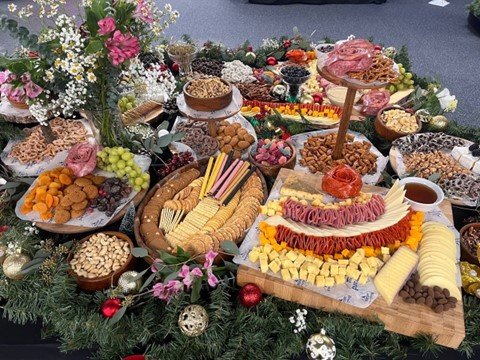Dietary Restrictions & Inclusive Menus: Navigating Gluten-Free, Vegan, Low-Sugar Options for DC Events

You are the planner of the ideal DC corporate party. The room looks stunning. This is the invitation list of the district. However, at dinner, a certain silence is observed at a number of tables. One of the guests is chewing a salad, and his main meal remains uneaten. Another has a hesitant look. You suddenly realize the menu, while beautiful, has left them out.
This scenario is every event planner's quiet fear. The dietary needs do not have a niche today. It is the essence of welcoming hospitality. A gluten-free request is not a preference only. It's a medical necessity for a guest with celiac disease. A vegan meal is often a deeply held ethical choice.
So, how do you create a menu that wows everyone? How do you ensure no guest feels like an afterthought? This guide will walk you through it. We'll navigate the world of gluten-free, vegan, and low-sugar options. You'll learn how to plan with confidence. And create an event where every single guest feels considered and celebrated.
Why Inclusive Menus are Non-Negotiable in 2025
Gone are the days of one rubbery chicken breast for all. The way we eat has fundamentally changed.
Think about your own office. You likely have vegan colleagues. Friends who avoid gluten. Family members are watching their sugar intake. This is the new normal.
An inclusive menu is no longer a special request. It's a mark of a truly successful event. It shows foresight. It shows care. It tells your guests, "We see you, and we've got you." This builds deeper connections. It fosters a sense of community. And let's be practical, it simply prevents those awkward moments at the table.
Demystifying Common Dietary Needs
Let's break down the big three. Understanding the why behind each need helps you appreciate the how of catering to them.
1. The Gluten-Free Guest: Beyond a Trend
For some, gluten-free is a lifestyle. For others, it's critical. Celiac disease is an autoimmune disorder. Even a crumb from a regular loaf of bread can cause a serious reaction.
- • What to Avoid: Wheat, barley, rye, and most oats (due to cross-contamination).
- • Inclusive Swaps: Instead of regular pasta, serve a stunning rice noodle salad. Offer quinoa as a hearty, protein-packed side. For passed hors d'oeuvres, a polenta crostino is a beautiful and safe alternative.
2. The Vegan Guest: A Plant-Based Plate Full of Flavor
Veganism excludes all animal products. No meat, no dairy, no eggs, no honey. The goal is to create a dish that is so satisfying, everyone at the table wants a bite.
- • What to Avoid: The apparent meats and cheeses, as well as the concealed ones, such as whey or gelatin.
- • Inclusive Swaps: Creamy cashew sauces can replace dairy in pastas. Lentils and mushrooms are used to make main dishes have a meaty texture. Even vegan meringues can be made with aquafaba (the liquid of a chickpea can).
3. The Low-Sugar Guest: Sweetness Without the Spike
This group includes diabetics, keto followers, and anyone mindful of their health. The goal is to avoid blood sugar spikes while still enjoying a satisfying meal and even dessert.
- • What to Avoid: Refined sugars, sugary sauces, and high-glycemic fruits.
- • Inclusive Swaps: Use natural sweetness from roasted vegetables or a hint of maple syrup. Offer a fresh berry medley for dessert instead of a rich, syrupy cake. Dark chocolate (70%+) is almost always a crowd-pleaser.
Your 5-Step Blueprint for an Inclusive Menu
Planning is power. Follow these steps for a seamless, stress-free experience.
- 1. Ask the Right Questions Early. On your digital RSVP, include a clear dietary restrictions field. Make it a required dropdown: "None," "Gluten-Free," "Vegan," "Vegetarian," "Other (please specify)." This gives your caterer a precise headcount.
- 2. Collaborate with a Creative Caterer. This is the most important step. Your caterer should be your partner. Ask them: "How do you handle cross-contamination in the kitchen?" "Can you show me examples of vibrant vegan entrees?" Their answers will tell you everything.
- 3. Design a "Mix and Match" Menu. This is the secret weapon. Instead of labeling one entree as "Vegan," build your menu with interchangeable components.
- • A Great Example: A Taco Bar.
- • Proteins: Cumin-roasted Chicken, Spiced Black Beans (Vegan/GF).
- • Toppings: Pico de Gallo (Vegan/GF), Guacamole (Vegan/GF), Shredded Lettuce, Cashew Crema (Vegan), Cotija Cheese.
- • Shells: Corn Tortillas (Vegan/GF), Flour Tortillas.
- • Everyone builds their perfect plate. No one feels singled out.
- 4. Prioritize Safety in Service. For serious allergies like celiac disease, separate serving utensils are a must. A dedicated team member should handle these dishes to prevent cross-contact. This isn't just careful, it's critical.
- 5. Label Everything Clearly. Use elegant, simple signage. Don't just use initials. Write it out: "Gluten-Free," "Vegan," "Dairy-Free." This empowers guests and saves your staff from answering the same question all night.
The Final Touch: Creating Connection Through Food
Food is more than food. It is the core of any party. It is the neutral place, where relationships grow and communication begins. By providing a thoughtful treatment to each guest, you do not feed them, you feed them. You honor them. You respect their health, their faith and their decisions.
That's the power of a truly inclusive menu. It transforms a standard event into an exceptional experience. It ensures the only thing your guests are talking about is how amazing they feel.
Ready to craft a menu that delights every single one of your guests? Our team at Boulevard Catering lives for this. Our menu is made by hand, and we have included everyone in it, as well as being delicious. How about creating the next DC event that will be remembered forever due to the right reasons?

